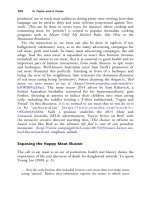The palgrave international handbook of a 501
Bạn đang xem bản rút gọn của tài liệu. Xem và tải ngay bản đầy đủ của tài liệu tại đây (33.49 KB, 1 trang )
504
M. Gupta et al.
violence. The program curriculum includes conflict resolution, empathy, coping strategies, animal care education, and working with shelter dogs.
Challenges and Strategies for Developing More
Effective Interventions
We now turn to an analysis of the factors that have hindered the development of interventions for animal abuse—including the aforementioned, lack
of data, but also extending to systemic challenges in intervention referrals,
practitioner familiarity, and overall understanding of animal abuse. For each,
we present recommendations and calls to action for overcoming the obstacles
and laying the foundation for enhanced approaches to intervention.
Fixing the Referral Pipeline
In order to provide interventions to those who abuse animals, it is first
necessary to find them. Animal abusers do not typically wear signs labeling
themselves, nor do most share common distinguishing features that make
them readily identifiable. Further, as with other violent behaviors and illegal
activities, most people who harm animals do not self-refer for help: they do
not wish to disclose the behavior, and/or do not see it as a problem. The most
common ways in which the social service system encounters individuals who
have abused animals, then, are:
• through referral from the courts
• in the case of minors, through referral by parents/guardians
• through discovery of animal abuse that was not part of the initial presenting problem or referral question
Beyond the challenges inherent in working with what is generally an
unwilling population, each of these referral paths is riddled with speed
bumps and a few possible potholes:
Court Referral. It is likely that the majority of cases of animal abuse never
reach the courts. Animal abuse is often a clandestine act, and its victims can
neither report the crime nor identify their abusers. Animal cruelty laws, while
improving, remain weak compared to laws for other violent crimes.
Enforcement of cruelty laws is chronically underpowered and underfunded.
For those cases that do enter the justice system, charges may be dropped or









